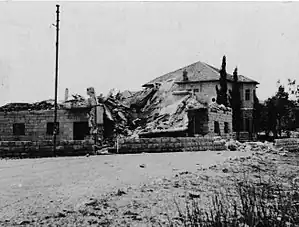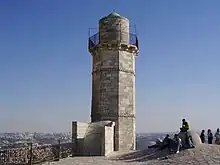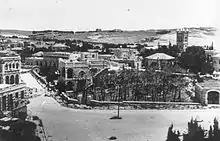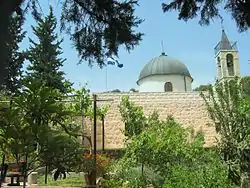| Operation Yevusi | |||||||
|---|---|---|---|---|---|---|---|
| Part of 1947–1948 Civil War in Mandatory Palestine | |||||||
 Katamon after Operation Yevusi | |||||||
| |||||||
| Belligerents | |||||||
| Commanders and leaders | |||||||
| Yitzhak Sadeh[1] |
Ibrahim Abu Daya Kamil Uraiqat (local irregulars) | ||||||
| Strength | |||||||
| Two brigades | unknown | ||||||
| Casualties and losses | |||||||
| Over 70 | Over 80 | ||||||
Operation Yevusi (Hebrew: מבצע יבוסי) (Eng. Jebusite), also known as the second "Battle of Nebi Samwil," was a Palmach military operation carried out during the 1948 Arab–Israeli War to assert Jewish control over Jerusalem.[2] The operation, commanded by Yitzhak Sadeh, lasted two weeks, from 22 April 1948 to 3 May 1948. Not all objectives were achieved before the British enforced a ceasefire.[3]
History

Operation Yevusi was mounted in the wake of the Battle for Jerusalem. The operation had four objectives: Control of Nabi Samuel, an Arab village northwest of Jerusalem and the highest point in the area; Sheikh Jarrah, an Arab residential quarter north of the city wall controlling the road to Mount Scopus; Katamon, a middle class, mainly Arab Christian suburb of southwest Jerusalem; and Augusta Victoria east of the Old City.[4]
Nabi Samuel and Sheikh Jarrah
The Harel Brigade arrived in Jerusalem on Wednesday 21 April. Their convoy had taken eight hours under fire to reach the city. The following day they started attacking the ridge of Nabi Samuel, but on the 23rd a company from Harel was ambushed and forced to retreat, losing 30-40 men.[5][6][7] On the night of 24/25 April, Sadeh occupied Sheikh Jarrah, where 40 Arabs were killed[8] and 20 homes were blown up.[9]

General Macmillan, commander of the British forces in Palestine, called on the Jewish forces to retreat because British forces used this road to reach the north of the country. MacMillan promised to prevent the return of the Arabs. After the British Army opened fire, the Palmach withdrew. The British declared Sheikh Jarrah a demilitarized zone which armed troops from either side could not enter.[10]
Katamon
On 29 April, one week after the start of the operation, Sadeh switched the attack to Katamon. The main target was the Greek Orthodox San Simon monastery, which was held by local Arab fighters with a contingent of volunteers from Iraq. There was also a unit from the Arab Legion guarding the empty Iraqi Consulate. John Bagot Glubb ordered them to withdraw after the surrounding buildings had been taken. The attack began with a mortar and machine gun barrage, before members of Harel's 4th and 5th Battalions, aided by Etzion's 4th Battalion and totaling 120 men, struck south and eastwards from Neve Shaanan. The battle for the monastery lasted all day, with the number of Jewish fighters killed given by one source as forty, though other estimates are much lower. Another source states eighty Arabs were killed. During the evening of 30 April the area was shaken by two large explosions. By the following day, 1 May, the Jews had complete control of the area. Once again the British intervened and demanded a ceasefire. But this time the Jews remained in control of the area taken. While the attack on Katamon was taking place Arabs in the Old City fired on Jewish positions in Yemin Moshe and only stopped after action by the British Army.[11][12][13]
Aftermath

With the operation only partially successful, Sadeh left Jerusalem. Dov Joseph, the military governor of Jerusalem, ordered teams of men into Katamon to requisition all food they could find[14] to alleviate the severe food shortages caused by the Arab blockade which led to draconian rationing in March 1948.[15] The district was then looted. By the end of the war Israel had control of 12 of Jerusalem's 15 Arab residential quarters. An estimated minimum of 30,000 people had become refugees.[16][17][18] About 750 non-Jews remained in the occupied Arab neighbourhoods; many of them Greeks living in the Greek Colony.[19]
Awards and Medals
Israel
 Haganah Ribbon - Awarded to all those that served in the Haganah for at least 6 months between 1920-48.
Haganah Ribbon - Awarded to all those that served in the Haganah for at least 6 months between 1920-48. Decoration of State Warriors - Awarded to members of military or paramilitary organizations who fought for the establishment of the state of Israel.
Decoration of State Warriors - Awarded to members of military or paramilitary organizations who fought for the establishment of the state of Israel. Defence of Jerusalem Badge - Awarded to every soldier who served under the command of the O.C. Jerusalem area between 1 April 1948 and 10 June 1948.
Defence of Jerusalem Badge - Awarded to every soldier who served under the command of the O.C. Jerusalem area between 1 April 1948 and 10 June 1948. Katamon Medal - The Katamon Medal was first struck in May 1948 and presented in July 1949 to soldiers that were present at the battle. Soon after it was awarded, the IDF withdrawal recognition of the medal.[20]
Katamon Medal - The Katamon Medal was first struck in May 1948 and presented in July 1949 to soldiers that were present at the battle. Soon after it was awarded, the IDF withdrawal recognition of the medal.[20]
United Kingdom (Inc Arab Legion)
 General Service Medal (1918) with "PALESTINE 1945-48" clasp
General Service Medal (1918) with "PALESTINE 1945-48" clasp
See also
References
- ↑ War in Palestine, 1948: strategy and diplomacy, David Tal
- ↑ In the shadow of the struggle, Ervin Birnbaum
- ↑ Collins, Larry & Lapierre, Dominique (1972) O Jerusalem! History Book Club edition by arrangement with Weidenfeld & Nicolson. Page 301. Sadeh to Rabin: "If we can get away with this Jerusalem will be all ours forty eight hours after the British leave."
- ↑ Kimche, Jon; Kimche, David (1960). A Clash of Destinies. The Arab-Jewish War and the Founding of the State of Israel. Frederick A. Praeger. p. 136. LCCN 60-6996. OCLC 1348948.
- ↑ Kimche, Page 135, 136. Has "over 40 killed". The Palmach memorial website has 2 killed on 22 April, 32 killed on 23 April.
- ↑ Collins/Lapierre. Page 306. "35 Palmachniks killed."
- ↑ Herzog, Chaim (1982) The Arab-Israeli Wars. War and Peace in the Middle East. Arms and Armour Press. ISBN 0-85368-367-0. Page 40. "due to poor timing."
- ↑ War in Palestine, 1948: strategy and diplomacy, David Tal
- ↑ Collins/Lapierre. Page 306. 6pm 27 April and withdrawal to Mount Scopus.
- ↑ War in Palestine, 1948: strategy and diplomacy, David Tal
- ↑ Kimche. Page 136. 80 Arabs dead, "attacking force suffered 10 killed." Page 138. Closing the road from Hebron.
- ↑ Herzog. Page 40. Numbers of Battalions, number of men attacking and 40 dead. Mentions Iraqi Arab Liberation Army irregulars.
- ↑ Glubb, Sir John Bagot (1957) A Soldier with the Arabs. Hodder and Stoughton. Pages 72,73.
- ↑ Collins/Lapierre. Pages 309, 313. Dov Joseph's order and Sadeh's departure.
- ↑ Joseph, Dov (1960). The faithful city: the siege of Jerusalem, 1948. Simon and Schuster. p. 34. LCCN 60-10976. OCLC 266413.
- ↑ Collins/Lapierre. Pages 309, 313. Dov Joseph's order and Sadeh's departure.
- ↑ Cattan, Henry (1981) Jerusalem. Croom Helm. ISBN 0-7099-0412-6. Page 51. Number of Arab districts under Jewish control.
- ↑ Asali, K.J. (1989) Jerusalem in History. Scorpion Publishing. ISBN 0-905906-70-5. Page 259. Estimate of number of refugees. (Michael C. Hudson)
- ↑ Journal of Palestine Studies, 160 Volume XL, Number 4, Summer 2011. Amit, Gish Salvage or Plunder? Israel's "Collection" of Private Palestinian Libraries in West Jerusalem. Page 8. Puts the pre-war non-Jewish population of Qatamon, Talbiyya, Baq'a, Musrar, the German and Greek Colonies, and Abu Tor at 28,000.
- ↑ "The Qatamon Medal". Israeli Decorations. Retrieved 27 October 2020.